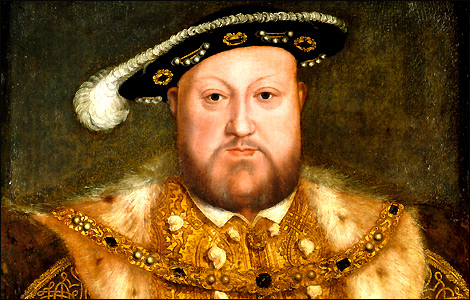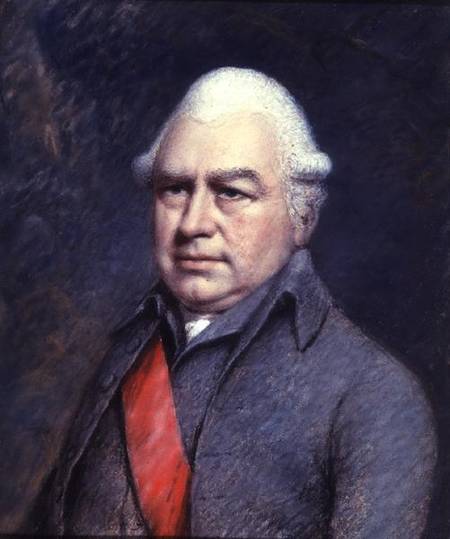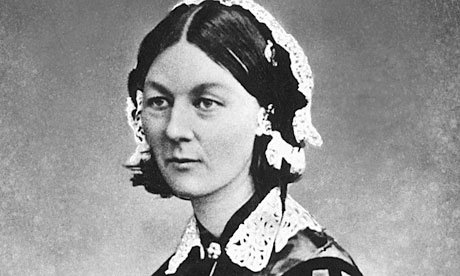The story of Lady Godiva is an enduring one – find out here the facts about her that are known to be true, alongside the tale that has been handed down through the years.
Who was Lady Godiva?
Godiva (Old English: Godgifu, “god gift”), often referred to as Lady Godiva, was an 11th-century Anglo-Saxon noblewoman who, according to a legend dating back at least to the 13th century, rode naked through the streets of Coventry in order to gain a remission of the oppressive taxation imposed by her husband on his tenants. The name “Peeping Tom” for a voyeur originates from later versions of this legend in which a man named Tom had watched her ride and was struck blind or dead.
The story of Lady Godiva’s ride, naked, through the streets of Coventry has changed and grown over the 900 years or so of its existence – but who was the real person behind the legend?
Lady Godiva was married to Leofric, the ‘grim’ Earl of Mercer and Lord of Coventry, a man of great power and importance. The chronicler Florence of Worcester mentions Leofric and Godiva, but does not mention her famous ride, and there is no firm evidence connecting the rider with the historical Godiva.
In 1043 the Earl and Countess founded a Benedictine house for an abbot and 24 monks on the site of St Osburg’s Nunnery, which had been destroyed by the Danes in 1016. The monastery was dedicated by Edsi, Archbishop of Canterbury, to God, the Virgin Mary, St Peter, St Osburg and All Saints.
During the dedication ceremony, Earl Leofric laid his founding charter upon the newly consecrated altar, which not only granted the foundation, but also gave him lordship over 24 villages for the maintenance of the house.
Lady Godiva endowed the monastery with many gifts in honour of the Virgin Mary. She is supposed to have had all her gold and silver melted down and made into crosses, images of saints and other decorations to grace her favoured house of God.
Leofric died in 1057 and was buried with great ceremony in one of the porches of the Abbey church. Lady Godiva survived her husband by ten years and is also said to have been buried in the church, although this has not yet been proven.
She rode through the silent streets unseen by the people…
On her deathbed, she gave a heavy gem-encrusted gold chain to the monastery, directing that it should be placed around the neck of the image of the Virgin. Those who came to pray, she said, should say a prayer for each stone in the chain.
The remains of the subsequent 13th-century church monastery, Coventry’s first cathedral, can now be seen in Priory Row.
The Godiva legend
The legend of the nude ride is first recorded in the 13th century, in the Flores Historiarum and the adaptation of it by Roger of Wendover; despite its considerable age, it is not regarded as plausible by modern historians, nor mentioned in the two centuries intervening between Godiva’s death and its first appearance, while her generous donations to the church receive various mentions. According to the typical version of the story Lady Godiva took pity on the people of Coventry, who were suffering grievously under her husband’s oppressive taxation. Lady Godiva appealed again and again to her husband, who obstinately refused to remit the tolls. At last, weary of her entreaties, he said he would grant her request if she would strip naked and ride through the streets of the town.
Lady Godiva took him at his word and, after issuing a proclamation that all persons should stay indoors and shut their windows, she rode through the town, clothed only in her long hair. Just one person in the town, a tailor ever afterwards known as Peeping Tom, disobeyed her proclamation in one of the most famous instances of voyeurism In the story, Tom bores a hole in his shutters so that he might see Godiva pass, and is struck blind.[20] In the end, Godiva’s husband keeps his word and abolishes the onerous taxes.
Some historians have discerned elements of pagan fertility rituals in the Godiva story whereby a young “May Queen” was led to the sacred Cofa’s tree perhaps to celebrate the renewal of spring The oldest form of the legend has Godiva passing through Coventry market from one end to the other while the people were assembled, attended only by two knights. This version is given in Flores Historiarum by Roger of Wendover (died 1236), a somewhat gullible collector of anecdotes, who quoted from unnamed earlier writers.
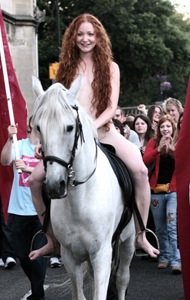 Other attempts to find a more plausible rationale for the legend include one based on the custom at the time for penitents to make a public procession in their shift, a sleeveless white garment similar to a slip today and one which was certainly considered “underwear”. Thus Godiva might have actually travelled through town as a penitent, in her shift. Godiva’s story could have passed into folk history to be recorded in a romanticised version. Another theory has it that Lady Godiva’s “nakedness” might refer to her riding through the streets stripped of her jewellery, the trademark of her upper class rank. However, both of these attempts to reconcile known facts with legend are weak; in the era of the earliest accounts, the word “naked” is only known to mean “without any clothing whatsoever”.
Other attempts to find a more plausible rationale for the legend include one based on the custom at the time for penitents to make a public procession in their shift, a sleeveless white garment similar to a slip today and one which was certainly considered “underwear”. Thus Godiva might have actually travelled through town as a penitent, in her shift. Godiva’s story could have passed into folk history to be recorded in a romanticised version. Another theory has it that Lady Godiva’s “nakedness” might refer to her riding through the streets stripped of her jewellery, the trademark of her upper class rank. However, both of these attempts to reconcile known facts with legend are weak; in the era of the earliest accounts, the word “naked” is only known to mean “without any clothing whatsoever”.
A modified version of the story was given by printer Richard Grafton, later elected MP for Coventry. According to his Chronicle of England (1569), “Leofricus” had already exempted the people of Coventry from “any maner of Tolle, Except onely of Horsse (sic.)”,[citation needed] so that Godiva (“Godina” in text) had agreed to the naked ride just to win relief for this horse tax. And as a pre-condition, she required the officials of Coventry to forbid the populace “upon a great pain” from watching her, and to shut themselves in and shutter all windows on the day of her ride. Grafton was an ardent Protestant and sanitized the earlier story.
The ballad “Leoffricus” in the Percy Folio (ca. 1650) conforms to Grafton’s version, saying that Lady “Godiua” performed her ride to remove the customs paid on horses, and that the town’s officers ordered the townsfolk to “shutt their dore, & clap their windowes downe,” and remain indoors on the day of her ride.
So what is the truth behind the story of Lady Godiva’s ride through Coventry? Why would a lady of great standing in the town do such a thing? The legend has been handed down over many years, so the line between fact and fiction has become more than a little blurred.
The earliest surviving source for the legend is the Chronica of Roger of Wendover for the year 1057. He wrote that Godiva pleaded with her husband to relieve the heavy burden of taxes he had imposed on the citizens of Coventry.
Weary of her persistence, Leofric said he would grant her request if she would ride naked through the town.
The rest of the story is not documented at all, but it is said that so great was her compassion for the people of Coventry that Godiva overcame her horror of doing this. She ordered the people to remain indoors with their windows and doors barred. Loosening her long hair to cover her as a cloak, she mounted her waiting horse.
Then she rode through the silent streets unseen by the people, who had obeyed her command because of their respect for her.
The story tells how Godiva pleaded with her husband to relieve the heavy burden of taxes he had imposed upon the citizens.
Only one man, called Tom, was unable to resist the temptation to peep at the Countess (hence the term ‘Peeping Tom’). He unbarred his window, but before he could satisfy his gaze he was struck blind.
Her ordeal completed, Godiva returned to her husband, who fulfilled his promise to abolish the heavy taxes. According to Ranulf Higden’s Polychronicon, Leofric freed the town from all tolls save those on horses. An inquiry made in the reign of Edward I shows that indeed, at that time, no tolls were paid in Coventry except on horses.
A pageant is held annually in Coventry to re-enact Lady Godiva’s original route through the town.
Peeping Tom
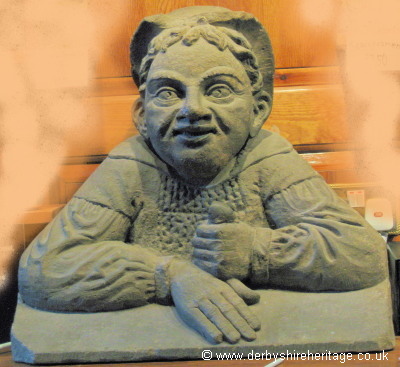
The statue of Peeping Tom peeped from the parapet of Derwent Hall’s stables before being rescued when the Hall was lost beneath the Derwent reservoir. The hall was built in 1692 by the Balguy family and subsequently became the seat of the Duke of Norfolk and in 1932 it was the first stately home to become a Youth hostel.
The later embellished episode of “Peeping Tom”, who alone among the townsfolk peeked at the Lady Godiva riding naked, probably did not originate in literature, but came up through popular lore in the locality of Coventry. Reference by 17th-century chroniclers has been claimed, but in the following all published accounts are 18th-century or later.
According to an 1826 article submitted by a person well-versed in local history identifying himself as W. Reader, there was already a well-established tradition before his time that there was a certain tailor who had taken a peek at Lady Godiva, and that at the annual Trinity Great Fair (now called the Godiva Festival) featuring the Godiva processions “a grotesque figure called Peeping Tom” would be set on display, and it was a wooden statue carved from oak. The author has dated this effigy, based on the style of armour he is shown wearing, from the reign of Charles II (d. 1685). The same writer felt the peeper legend had to postdate William Dugdale (d. 1686) since antiquary made no mention in his huge tomes that discussed Coventry in extenso. (It should be noted that the lore about the tailor as peeper and the use of wooden effigy may be as old as the 17th century, but the effigy may not have always been called “Tom”. See 1773 date below, and the alternate suggested name “Action”.)
W. Reader dates the first Godiva procession to 1677,but other sources date the first parade to 1678, and on that year a lad from the household of James Swinnerton enacted the role of Lady Godiva.
Regarding the track record of Godiva’s peeper as recorded in published writings, the English Dictionary of National Biography gives a meticulous account. The historian Paul de Rapin (1732) reported the Coventry lore that Lady Godiva performed her ride while “commanding all Persons to keep within Doors and from their Windows, on pain of Death” but one man could not refrain from looking and it “cost him his life”; Rapin further reported that the town commemorates this with a “Statue of a Man looking out of a Window.”
Next, Thomas Pennant in Journey from Chester to London (1782) recounted how “the curiousity of a certain taylor overcoming his fear, he took a single peep”.[citation needed] Pennant noted that the person enacting Godiva in the procession was not fully naked of course, but wore “silk, closely fitted to her limbs”, which had a color resembling the skin’s complexion.[35] (In Chester’s time around 1782 silk was worn, but the annotator of the 1811 edition noted that a cotton garment had since replaced the silk fabric.) According to the Dict. Nat. Biog., the oldest document that mentions “Peeping Tom” by name is a record in Coventry’s official annals, dating to June 11, 1773, documenting that the city issued a new wig and paint for the wooden effigy. There is further description given on the Godiva procession under the sub-article Lady Godiva in popular culture.
There is also said to be a letter from pre-1700, stating that peeper was actually Action (pronounced Actæon?), Lady Godiva’s groom.
Additional legend proclaims that Peeping Tom was later struck blind as heavenly punishment, or that the townspeople took the matter in their own hands and blinded him.
The Peeping Tom story is absent from the few sources contemporary with Godiva. It has been pointed out that Tom (Thomas) is not an Anglo-Saxon name, and therefore hardly likely to be a name of a townsperson governed by Leoffric. Coventry was still a small settlement, with only 69 families (and the monastery) recorded in the Domesday Book some decades later. Lastly, the only recorded tolls were on horses. Thus, it remains doubtful whether there is any historical basis for the famous ride. The story is particularly doubtful since Countess Godiva would herself have been responsible for setting taxation in Coventry; Salic law, which excluded females from the inheritance of a throne or fief, did not apply in Anglo-Saxon society. If only because of the nudity in the story, its popularity has been maintained, and spread internationally, with many references in modern popular culture.
Credits:
BBC
Wikipedia


